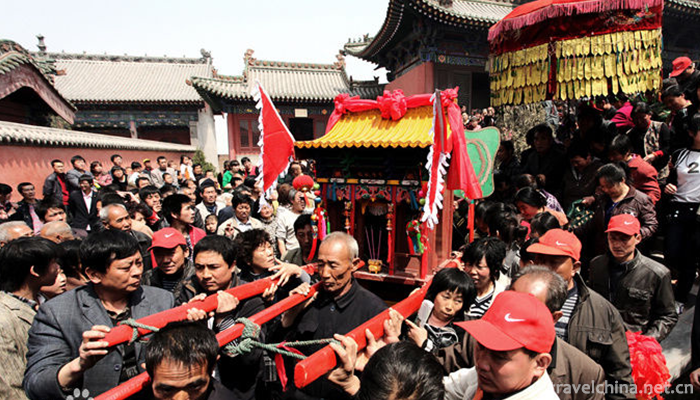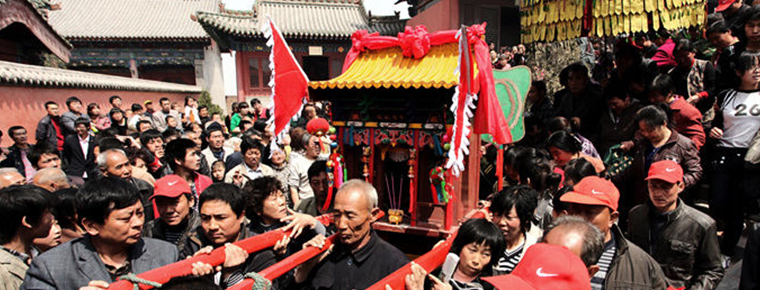Hongdongs custom of visiting relatives
Hongdongs custom of visiting relatives
The custom of walking relatives in Hongdong is a kind of Han traditional folk culture which spreads in Ganting, Wucun, Xincun, Longma and Wanan townships in Hongdong County and Yaodu District of Linfen City, Shanxi Province. It involves more than 20 villages and crosses the East and West banks of the Fenhe River. The local Han people are known as "going to relatives on March 3rd" and "taking aunts to meet their mothers", which are related to the legend of the marriage relationship between Emperor Yao's daughter "Nv Ying" and Shun. The first batch and the second batch of national intangible cultural heritage in Shanxi Province.
historical origin
As an ancient folk culture of the Han nationality, Hongdong's family-walking activities span five townships, Ganting, Wucun, Xincun, Longma and Wan'an, in two counties (districts) of Linfen City, Shanxi Province. They involve more than 20 villages and cross the East and West banks of the Fenhe River, with a wide range of influence.
There is a local legend about the activity of "receiving aunts and welcoming mothers" to visit relatives. The original name of the village is Zhoufu Village. Later, a ewe gave birth to a one-horned sheep. Its name is "Mao", which is a divine beast and has the ability to distinguish good from evil. As the Road History says, "Sex knows straight, knows guilty, and can not touch straight." The matter was known to Gao Tao, the sage of Shishicun and the judicial officer of Yao, and reported to Emperor Yao. King Yao of Pingyang, Dingdu, came to visit with his pregnant wife. Unexpectedly, his wife gave birth to female Ying in the land where she was born. Yao saw that there were God beasts and saints and babies in this area. He moved to live with his whole family and renamed the village as a goat otter. Shun Geng Li Shan is a well-known story in ancient books. Although there are more than 20 places in the name of Li Shan in China, the local people firmly believe that Shun cultivates in this Li Shan. They are favored by the visiting sage King Yao and marry E Huang and Nv Ying to Shun. Therefore, Otter and Lishan are the mother-in-law's and mother-in-law's families of the two goddesses respectively. Owing to the relationship of generations, Otter people call them "aunt", and Lishan and other places call them "mother-in-law". Every year on March 3rd of the lunar calendar, near the Qingming Dynasty, it is the day of grave sweeping and ancestor sacrifice. The goats pick them up from the calendar mountain to their mother's home and their relatives until April 28th (the birthday of King Yao). The calendars come to pay homage to King Yao and take the two mothers back. Then they will enter the busy season of agriculture.
(Atlas 2 of Hongtong's Family Visiting Customs Activities)
cultural meaning
First of all, the ceremony and legend of visiting relatives are important ways for the working people of the Han nationality to remember together and oral records of the evolution of regional history. Legend has a function of explanation. When people tend to obscure and forget history, history gradually evolves into memory and enters people's minds. When handed down from generation to generation, it gradually forms rich Han folklore. The legend of Yao and Shun and the explanation of the origin of the village name obviously have the nature of this common memory, which is also a warning to future generations not to forget history.
Secondly, the custom and legend of visiting relatives maintain a regional social order. Wherever people go during the activity, they are enthusiastic and pious, conveying a kind of social ethics, morality and taboos. Eating "waist meal" and staying in the village after dark have realized the process and purpose of family recognition and highlighted their attachment to family relations, which has played an important role in strengthening regional ties, especially in this society where the sense of space is becoming stronger and the interpersonal relationship is becoming more and more tense. Such family-visiting ceremonies will undoubtedly give people a lot of inspiration, about interpersonal and living space. Between. In short, the March 3 visiting ceremony has become an important belief and recreational activity besides farming and living in southern Shanxi, which affects people's attitude to life, values and relatives. It is a kind act for people to actively participate in and respond to the busy farming. It is a way to express their beliefs and wishes. It is also a way to vent their emotions. It seeks spiritual sustenance in their personal efforts and experiences, realizes the harmony between relatives and neighbours, and maintains their friendship with foreigners.
Inheritance situation
According to textual research, the earliest record of existence can only be seen that Shun Temple existed in Lishan during the Northern Song Dynasty (see Shanxi Tongzhi Temple). Therefore, the custom of "receiving aunts and welcoming their wives" should originate around the Song Dynasty. However, local people, local intellectuals and even government officials all believe that this is the true history and believe that the whole "receiving aunts and welcoming their wives" is true. Family visits have also been handed down from the Yao and Shun times, with a history of four to five thousand years. They are extremely proud of this and defend their beliefs with practical actions. Even during the period when such activities were strictly prohibited during the "Cultural Revolution", they still took risks and dressed up to secretly pick up their aunts. Many people were detained and imprisoned for this reason.


-
1.About Us
If you are interested in Chinese culture, Beautiful Scenery and Delicious Food, Welcome to China.
Time 2018-09-28 -
2.Duck blood soup with vermicelli
Duck blood vermicelli soup is a famous specialty in Nanjing, belonging to Jinling food...
Time 2018-10-26 -
3.Detian waterfall
Detian Waterfall is located in Detian Village, Shuolong Town, Daxin County, Chongzuo City, Guangxi Zhuang Autonomous Region. It is located in the upper reaches of Guichun River on the border between C
Time 2018-12-12 -
4.Mingsha Mountain Crescent Spring Scenic Area
Mingsha Mountain Crescent Spring Scenic Spot is located 5 kilometers south of Dunhuang City, Gansu Province. It covers an area of 312,000 square kilometers
Time 2018-12-12 -
5.Dongjiang Lake Tourist Area Coconut City
Dongjiang Lake Scenic Tourist Area is located in Zixing City, Hunan Province. It is a national scenic spot, a national 5A scenic spot and a national wetland park.
Time 2018-12-12 -
6.Hailing Island Dajiao Bay Sea Silk Road Tourist Area Yangjiang City
Dajiaowan Scenic Area of Hailing Island in Yangjiang is located in Zhapo Town of Hailing Island, Yangjiang City, Guangdong Province.
Time 2019-01-13 -
7.Zhangjiakou Zhangbei Grassland
Zhangbei grassland is located in Zhangbei County, 70 kilometers northwest of Zhangjiakou. It consists of two grasslands, Zhongdu and Angoli. In Zhangbei grassland, you can ride horses and shoot arrows
Time 2019-03-10 -
8.Tune in the sea
Linhai Ci Tune, also known as Taizhou Ci Tune, Talent Ci Tune and Xianhe Tune, is developed from Nanci, Kunqu and Taizhou local folk minor. It is one of the folk songs of Taizhou, Zhejiang Province. I
Time 2019-05-13 -
9.southern accent
Nanyin, also known as "string" and "Quanzhou Nanyin", is the oldest ancient music in China. During the Han, Jin, Tang and Song dynasties, the immigrants from the Central Plains bro
Time 2019-06-07 -
10.Ningbo Gold and Silver Embroidery
Ningbo gold and silver embroidery is one of the Han folk handicraft products embroidered on silk fabrics with various color threads, gold threads and silver threads. With its strong local characterist
Time 2019-06-07 -
11.Production Techniques of Tongshengxiang Beef and Mutton Bubble
Tongshengxiang steamed beef and mutton steamed bun was founded in 1920. It was named Tongshengxiang with the meaning of "prosperity and auspiciousness". Its steamed bread is made of meat of
Time 2019-06-21 -
12.Yibin medical and health
By the end of 2019, there are 5120 medical and health institutions in Yibin City, including 135 hospitals (102 private hospitals); 4945 primary medical and health institutions, including 177 township health centers, 46 community health service centers (stations),
Time 2020-12-18